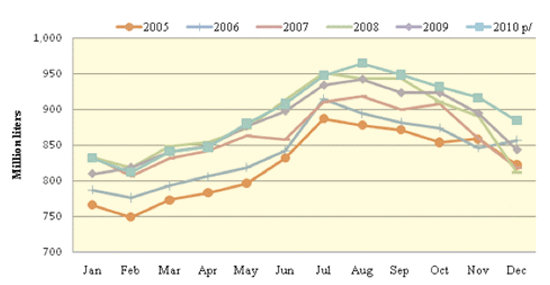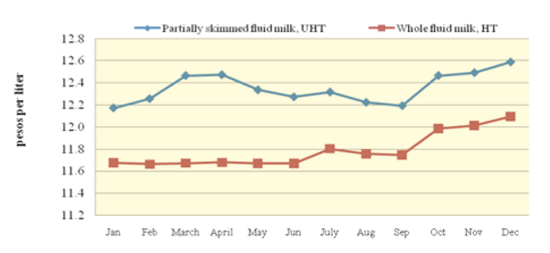



Mexican Fluid Milk Supply Lags Behind Processing Demand
Fluid milk production will be lower than expected but higher than in 2010, resulting in larger production of cheese and butter as well as higher imports of dairy raw materials, according to the US Foreign Agricultural Service.Commodities: Dairy Milk Fluid
Production:
The forecast for total fluid milk production in 2011 is revised down 1.5 per cent, 167 thousand metric tons (TMT) lower than official USDA estimates, based on a higher cost of production as compared to the expected price paid to producers and adverse weather conditions. According to the dairy processing industry, milk production costs are increasing mainly due to high feed and energy prices. For example, in the second week of April 2011 yellow corn prices had increased 120 per cent as compared to the same week in 2010.
Figure 1. Mexico: Monthly Bovine Fluid Milk Production, 2005 - 2010

Also, the lack of early rains in almost all of Mexico and the expected droughts in Coahuila, Durango, Chihuahua, and Jalisco will slightly decrease milk production for two reasons: grass supplies for both greenchop and hay will be reduced, and the better milk yields typical of the rainy season will be delayed, principally among small and medium-sized producers. Production in the four states mentioned above represents almost 50 per cent of total domestic fluid milk.
Another factor is that, in response to producers’ requests that LICONSA pay a 20 per cent increase in the fluid milk price per liter (to 5.6 pesos per liter), LICONSA agreed to only an estimated seven per cent increase (5 pesos or USD 0.42 per liter). This new price should be in place from April to the end of 2011 and available to small and medium-sized milk producers. As previously reported, the price paid by LICONSA is used as the domestic reference price, similar to the US type I milk price.
Cows-in-milk estimates for 2011and 2010 are revised downward 1.5 and 1.2 per cent, respectively, from official USDA data mainly due to a reduction in producer numbers and in live animal imports. Even though the worst of the recent economic crisis has passed, some small and medium-sized producers have left the dairy business, reducing the expected rise in cow inventories. In addition, milk producers´ efforts to improve yields through better breeding are lower than previously expected. During the first two months of 2011, Mexico imported 86 per cent fewer breeding animals and 55 per cent fewer milk cows than during the same period in 2010.
In addition, small and medium-sized dairies continue to face financial problems due to high production costs and low productivity. Relatively low domestic raw milk prices and a lack of affordable financing for capital improvements have discouraged small and medium-sized dairy farms from expanding, particularly in central and southern Mexico.
The estimates for total fluid milk production are revised 1.2 per cent downward from official USDA data based on official data obtained from the Food and Fisheries Statistics Service (SIAP). Official sources stated that this revision is the result of some small producers going out of business due to the economic crisis. This reduction also resulted in a lower-than-expected cows-in-milk figure for 2010, which was also revised 1.2 per cent lower than official USDA data. Fluid milk production and cows-in-milk data remain unchanged for 2009.
Consumption:
The new 2011 estimate of total fluid milk consumption is revised slightly downward as low and middle- income consumers have begun substituting the consumption of fluid milk with more expensive and value-added products, such as cheese and yogurt, as a source of dairy protein in their diets. This shift in preferences is made possible by the recovery in consumer buying power.
Total fluid milk consumption for 2010 is revised slightly downward from official USDA data, principally due to a reduction in the consumption of specialised fluid milk, such as partially skimmed, skimmed, nonfat, and flavored milk (including small cartons for children).
Based on newly available information, new estimates beginning in 2009 have been revised sharply upward for fluid use domestic consumption and downward for factory use domestic consumption. This revision was undertaken because the components of each item were reshuffled. Much of what was previously captured as factory use is now included as fluid milk. However, overall consumption has not changed significantly.
Fluid use domestic consumption estimates for 2011, 2010 and 2009 include fluid milk sold to big companies (e.g., Lala, Alpura, etc.) to produce pasteurised and shelf stable (UHT) fluid milk in different product lines (non-fat, low fat, whole, flavored, etc.) as well as the total fluid fresh milk sold directly by producers every day without refrigeration or industrial treatment, mainly to households and artisanal cheese producers. For example, the 2010 fluid milk domestic consumption estimate includes 370 million liters of milk sold to households and small cheese producers, 697 million liters to LICONSA, and 4.1 billion liters to big companies to produce UHT and HT milk.
Factory use domestic consumption estimates for 2011, 2010 and 2009 are revised downward (because they no longer consider the fluid milk sold by big companies (now included in fluid use domestic consumption) and only focus on milk that is processed into another form (e.g., butter, cheese, yogurt, NFDM, etc.).
According to industry sources’ estimates, approximately seven per cent of milk is consumed raw (a health concern) and 14 per cent is consumed through the government’s social programmes. It is important to note that LICONSA’s use of imported powdered milk has decreased significantly in the last 10 years. Consumption of UHT and pasteurized milk accounts for 80 per cent of total fluid milk consumption.
During the first quarter of 2011 LICONSA was paying the congressionally mandated minimum price of 4.40 pesos per liter (USD 0.37) to producers plus an additional 0.30 peso-per-liter premium for quality. However, due to continued pressure from producers and congress, LICONSA is starting to pay producers 4.70 pesos per liter (USD 0.40) plus an additional 0.30 peso-per-liter quality premium for a total price of 5 pesos (USD 0.42), which will likely be in effect for the remainder of the year.
Although milk production costs are increasing slightly due to higher grain prices, these costs will not be completely transferred to the consumer since milk processors are aware that the consumption of fluid milk remains stable only if prices do not increase more than 3 per cent.
Due to the economic crisis of 2010 some consumers preferred consuming whole fluid milk and pasteurized milk only, since it was cheaper than specialized fluid milk and UHT milk (see figures 2 and 3).
Figure 2. Mexico: Consumer Prices For Fluid Milk; Pasteurized Whole Vs. Ultra-High Temperature Partially Skimmed, 2010

Figure 3. Mexico: Fluid Milk Consumer Retail Prices, in Supermarkets, End of Month



